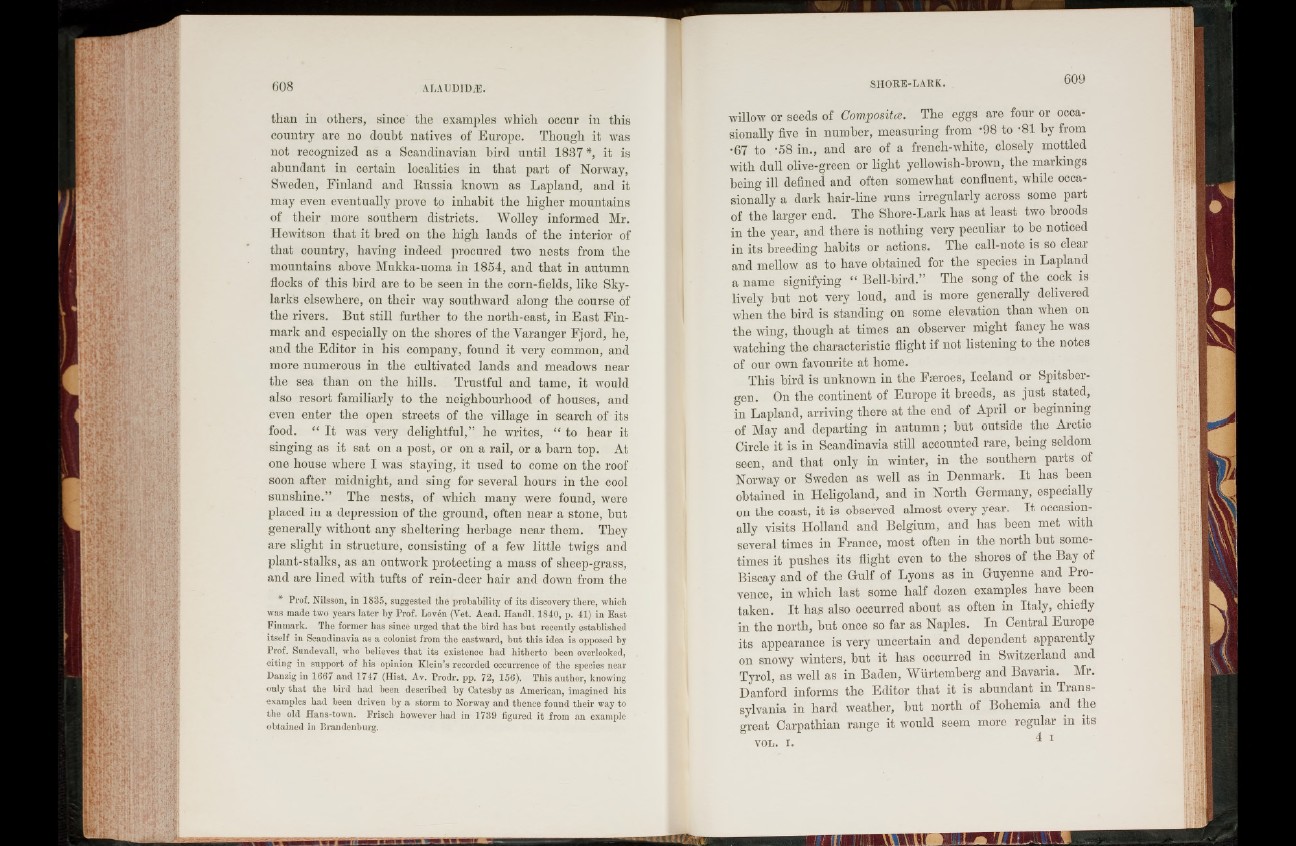
than in others, since the examples which occur in this
country are no doubt natives of Europe. Though it was
not recognized as a Scandinavian bird until 1837 *, it is
abundant in certain localities in that part of Norway,
Sweden, Finland and Russia known as Lapland, and it
may even eventually prove to inhabit the higher mountains
of their more southern districts. Wolley informed Mr.
Hewitson that it bred on the high lands of the interior of
that country, having indeed procured two nests from the
mountains above Mukka-uoma in 1854, and that in autumn
flocks of this bird are to he seen in the corn-fields, like Skylarks
elsewhere, on their way southward along the course of
the rivers. But still further to the north-east, in East Fin-
mark and especially on the shores of the Varanger Fjord, he,
and the Editor in his company, found it very common, and
more numerous in the cultivated lands and meadows near
the sea than on the hills. Trustful and tame, it would
also resort familiarly to the neighbourhood of houses, and
even enter the open streets of the village in search of its
food. “ I t was very delightful,” he writes, “ to hear it
singing as it sat on a post, or on a rail, or a barn top. At
one house where I was staying, it used to come on the roof
soon after midnight, and sing for several hours in the cool
sunshine.” The nests, of which many were found, were
placed in a depression of the ground, often near a stone, hut
generally without any sheltering herbage near them. They
are slight in structure, consisting of a few little twigs and
plant-stalks, as an outwork protecting a mass of slieep-grass,
and are lined with tufts of rein-deer hair and down from the
* Prof. Nilsson, in 1835, suggested the probability of its discovery there, which
was made two years later by Prof. Loven (Yet. Acad. Handl. 1840, p. 41) in East
Finmark. The former has since urged that the bird has but recently established
itself in Scandinavia as a colonist from the eastward, but this idea is opposed by
Prof. Sundevall, who believes that its existence had hitherto been overlooked,
citing in support of his opinion Klein’s recorded occurrence of the species near
Danzig in 1667 and 1747 (Hist. Av. Prodr. pp. 72, 156). This author, knowing
only that the bird had been described by Catesby as American, imagined his
examples had been driven by a storm to Norway and thence found their way to
the old Hans-town. Frisch however had in 1739 figured it from an example
obtained in Brandenburg.
Avillow or seeds of Covipositce. The eggs are four or occasionally
five in number, measuring from -98 to -81 by from
•67 to -58 in., and are of a french-white, closely mottled
with dull olive-green or light yellowish-brown, the markings
being ill defined and often somewhat confluent, while occasionally
a dark hair-line runs irregularly across some part
of the larger end. The Sliore-Lark has at least two broods
in the year, and there is nothing very peculiar to be noticed
in its breeding habits or actions. The call-note is so clear
and mellow as to have obtained for the species in Lapland
a name signifying “ Bell-bird.” The song of the cock is
lively but not very loud, and is more generally delivered
when the bird is standing on some elevation than when on
the wing, though at times an observer might fancy he was
watching the characteristic flight if not listening to the notes
of our own favourite at home.
This bird is unknown in the Faroes, Iceland or Spitsbergen.
On the continent of Europe it breeds, as just stated,
in Lapland, arriving there at the end of April or beginning
of May and departing in autumn; but outside the Arctic
Circle it is in Scandinavia still accounted rare, being seldom
seen, and that only in winter, in the southern parts of
Norway or Sweden as well as in Denmark. I t has been
obtained in Heligoland, and in North Germany, especially
on the coast, it is observed almost every year. I t occasionally
visits Holland and Belgium, and has been met with
several times in France, most often in the north but sometimes
it pushes its flight even to the shores of the Bay of
Biscay and of the Gulf of Lyons as in Guyenne and Provence,
in which last some half dozen examples have been
taken. I t has also occurred about as often in Italy, chiefly
in the north, but once so far as Naples. In Central Europe
its appearance is very uncertain and dependent apparently
on snowy winters, but it has occurred in Switzerland and
Tyrol, as well as in Baden, Wiirtemberg and Bavaria. Mr.
Danford informs the Editor that it is abundant in Trans-
sylvania in hard weather, but north of Bohemia and the
great Carpathian range it would seem more regular in its
j i n m u m r